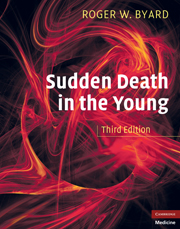Book contents
- Frontmatter
- Contents
- Preface to the third edition
- Reviews of the first and second editions
- Acknowledgments
- Section 1 Introduction
- 1 Sudden pediatric death: issues and overview
- Section 2 Unintentional trauma
- Section 3 International trauma
- Section 4 Natural disease
- Section 5 Maternal, fetal, and neonatal conditions
- Section 6 Sudden infant death syndrome
- Appendices
- Index
1 - Sudden pediatric death: issues and overview
from Section 1 - Introduction
Published online by Cambridge University Press: 05 January 2013
- Frontmatter
- Contents
- Preface to the third edition
- Reviews of the first and second editions
- Acknowledgments
- Section 1 Introduction
- 1 Sudden pediatric death: issues and overview
- Section 2 Unintentional trauma
- Section 3 International trauma
- Section 4 Natural disease
- Section 5 Maternal, fetal, and neonatal conditions
- Section 6 Sudden infant death syndrome
- Appendices
- Index
Summary
Introduction
There have been considerable developments in our understanding of pediatric natural diseases, including the discovery of many complex genetic links. For example, more than 900 disease genes have now been documented, each of which has from one to many hundreds of mutations. This places considerable responsibility on pediatric and forensic pathologists to correctly identify diseases that may present as sudden and unexpected childhood deaths, as family screening and genetic counseling may be required.
In addition to assessing the effects of natural diseases the pathologist also has to continually evaluate non-inflicted and inflicted trauma, and liaise with coroners, product safety experts, and community groups that deal with childhood injury prevention. Preventive pathology refers to this type of activity, with information being taken from the morgue back to the community for use in educational and intervention programs. Thus, pathological evaluation of cases of sudden childhood death involves much more than simple dissection and slide examination. Given the scope of this text a question to first address concerns the definition of the terms “sudden” and “unexpected.”
How sudden is “sudden?”
The definition of sudden death is quite variable, with different authors setting limits of zero, 1, 6 and 24 hours from the time of onset of symptoms and signs to the time of death.
- Type
- Chapter
- Information
- Sudden Death in the Young , pp. 1 - 6Publisher: Cambridge University PressPrint publication year: 2010
- 1
- Cited by



